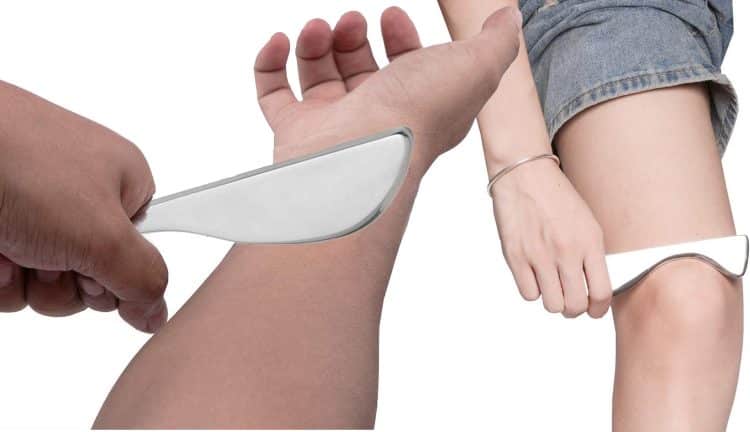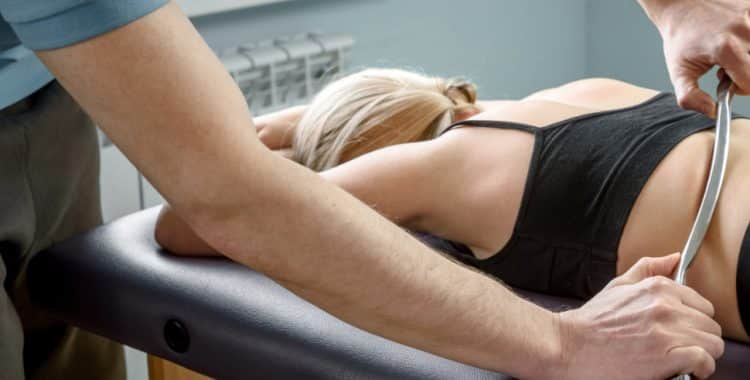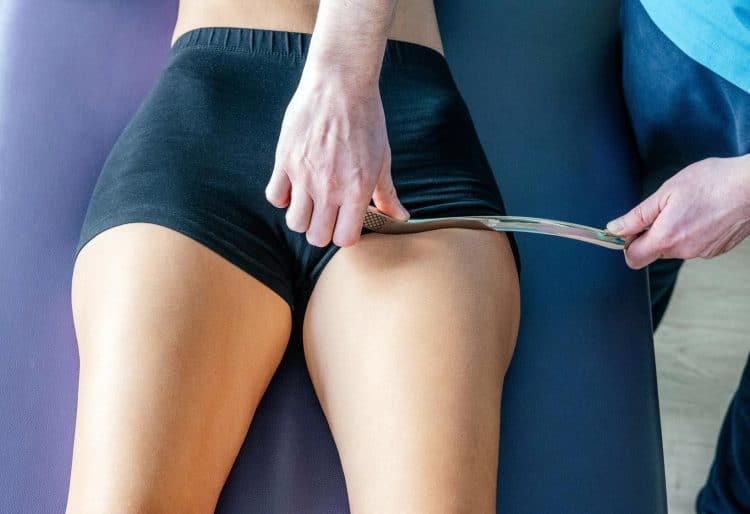Massage is arguably the oldest form of medicine. In fact, it’s something most people do instinctively in response to pain or muscle tension. If something hurts, you rub it – it’s human nature!
As medical science has advanced, different massage styles and techniques have emerged. These methods attempted to formalize what would otherwise be a freeform treatment that followed no set structure.
Examples of types of massage include:
- Swedish massage
- Sports massage
- Thai massage
- Deep tissue massage
- Lymphatic drainage massage
- Acupressure massage
- Cupping
And now, there is another type of massage to add to the list – muscle scraping, also known as gua sha, kerokan, spooning, coining, or the Graston technique.
The beauty of this treatment is you can perform it on yourself, and it may help you recover faster from workouts and injuries.
In this article, we explain why and how to do muscle scraping and whether it actually works.
Level Up Your Fitness: Join our 💪 strong community in Fitness Volt Newsletter. Get daily inspiration, expert-backed workouts, nutrition tips, the latest in strength sports, and the support you need to reach your goals. Subscribe for free!
What is Muscle Scraping?
Muscle scraping is a soft tissue therapy that involves scraping a blunt, smooth implement along the surface of a muscle. Like all forms of massage, this causes an increase in blood flow, speeds up the removal of metabolic waste products, and helps reduce muscle tension.
Muscle scraping has been part of traditional Chinese medicine for many centuries and is even mentioned in the Shanghan Lun, which is an ancient Chinese medicine book from BC 220.
The Chinese name for muscle scraping is gua sha. Gua means coin, while sha means to scrape. Together, these words may also mean “to scrape sand,” with refers to the light pattern of light bruising that often accompanies a muscle scraping treatment, as well as the texture you may feel beneath the skin during scraping.
In Chinese medicine, muscle scraping is believed to improve the flow of energy or qi. However, Western medical studies have reported that this treatment increases tissue temperature and blood flow (1) and can even increase strength and athletic performance (2).
In a medical setting, muscle scraping is usually done using a special stainless-steel tool. Still, you can use almost any blunt-edged object to do it – even a flat pebble. Ancient Chinese practitioners used animal jaw bones, and some more spiritual types use scrapers made from crystals, which they believe to impart additional healing effects, although science doesn’t tend to support this.
The tool is used in conjunction with oil, so it slides over the skin more easily and won’t cause abrasions. You can use many different oils for this purpose, including sweet almond oil, jojoba oil, and even olive oil.
What Are the Benefits of Muscle Scraping?
Like most soft tissue treatments, such as self-myofascial release (SMR or foam rolling), muscle scraping has several effects and benefits. While some of these effects have been confirmed by studies, others are more anecdotal. However, the fact that gua sha has been used for about 2,000 years strongly suggests that it works.
The reported effects and benefits of muscle scraping include:
Improved blood flow
Muscle scraping stimulates the blood vessels and capillaries, so they dilate or open up to allow better blood flow. Also, as you scrape along the muscle, blood is pushed along the blood vessels.
Improved blood flow will help remove waste products from the muscles, infuse the area with freshly oxygenated blood, and speed up recovery from intense exercise. Better blood flow also helps injuries to heal faster, especially in tendons which do not have good circulation to begin with.
Level Up Your Fitness: Join our 💪 strong community in Fitness Volt Newsletter. Get daily inspiration, expert-backed workouts, nutrition tips, the latest in strength sports, and the support you need to reach your goals. Subscribe for free!
Improved range of motion
In studies, muscle scraping helped increase flexibility and mobility in computer operators (3), so it’s no great leap to think that it won’t do the same for athletes.
Muscle scraping passively stretches the muscle fibers and helps eliminate adhesions between muscles and the surrounding fascia. Adhesions are like fibrous knots that can prevent smooth movement.
Reduced muscle pain
Pain is often caused by trigger points of tension in the muscles and/or fascia. These trigger points interfere with the normal flow of blood, inhibit movement, and lead to the buildup of lactic acid. Muscle scraping has been shown to reduce lower back pain and, as such, could be used to treat pain in other parts of the body, such as the shoulders or elbows.
Better workout performance
Muscle scraping may help reduce fatigue, decrease rating of perceived exertion (RPE), alleviate workout pain, lower training heart rate, and otherwise increase exercise performance (5). Needless to say, harder, better workouts will lead to faster progress, no matter what you are training for.
How to Scrape Your Muscles
Providing you can easily reach the area you want to treat, you can scrape your own muscles. However, you will probably need to ask someone to scrape hard-to-reach areas such as your back. Alternatively, many bodyworkers offer muscle scraping, and physical therapists may use it as part of a more holistic approach to injury treatment.

You can use any blunt-edged tool for muscle scraping, including a broad spoon, thin pebble, or something similar. Or, you can buy a special muscle scraping tool online.
To perform muscle scraping:
- Apply your lubricating oil to the area you want to treat. Use a thin layer but have more near to hand because some will absorb into the skin.
- Starting with light, broad strokes, scrape down the area being treated, feeling for any grittiness or roughness under the edge of your tool. This unevenness indicates where you should concentrate your treatment.
- Note that you’ll also see redness around the area being treated, and the redder it is, the more you should focus on that area.
- Once you have identified the main area you want to work on, start to press a little deeper, using a smaller edge to intensify the treatment.
- Work up, down, and across the muscle with small but smooth movements, like you are scraping paint off an old wooden table.
- Flex and extend the muscle/area as you scrape to ensure that you work all the available fibers.
- Continue for 2-3 minutes, taking care not to cause a lot of pain. However, this treatment may be uncomfortable and will probably produce some light bruising.
- Finish off the muscle scraping treatment with some light massage to promote blood flow into the affected area.
- Remove any excess lubricant, and you’re done!
Do NOT use this treatment on areas of broken or irritated skin, over bony prominences, e.g., the front of your knee or back of your elbow joints, on fractures, or if you suspect a serious injury.
Here’s a video that should help clarify how to scrap your muscles.
Muscle Scraping – Wrapping Up
The large amount of research and anecdotal evidence strongly suggests that muscle scraping really works. It does everything that any good soft tissue treatment should do, increasing blood flow, reducing muscle tension, and encouraging repair and recovery.
However, because you’ll be using a hard implement, it’s very easy to be a little too enthusiastic and go too deep, causing more pain than is necessary. You don’t have to try and scrape the muscle off the bone to benefit from this treatment! Instead, it’s quite superficial and should not cause deep bruising or severe pain.
A trained muscle scraper, such as a physical therapist, MAY scrape more deeply, leaving you feeling sore and beat up afterwards, but you should not as you are not qualified to do so.
So, use muscle scraping to enhance recovery and treat minor injuries, but leave the more intense treatments to someone who really knows what they’re doing.
Of course, even muscle scraping is not a magic bullet, and aches and pains need time to repair themselves naturally. However, it certainly seems that muscle scraping could help speed up the process.
References:
1. PubMed: The Effects of Scraping Therapy on Local Temperature and Blood Perfusion Volume in Healthy Subjects https://www.ncbi.nlm.nih.gov/pmc/articles/PMC3359830/
2. Science Direct: Effect of Scraping Therapy on Weightlifting Ability https://www.sciencedirect.com/science/article/pii/S0254627214600546
3. Archive of Allied Health Services: Immediate Effects of Gua Sha Therapy for Reducing Neck and Shoulder Pain Associated with Myofascial Trigger Point in Computer Users https://he01.tci-thaijo.org
4. PubMed: Gua Sha therapy for chronic low back pain: A randomized controlled trial https://pubmed.ncbi.nlm.nih.gov/30712747/
5 – PubMed: Gua Sha Improves the Rating of Perceived Exertion Scale Score and Reduces Heart Rate Variability in Male Weightlifters: A Randomized Controlled Trial https://pubmed.ncbi.nlm.nih.gov/29956905/





